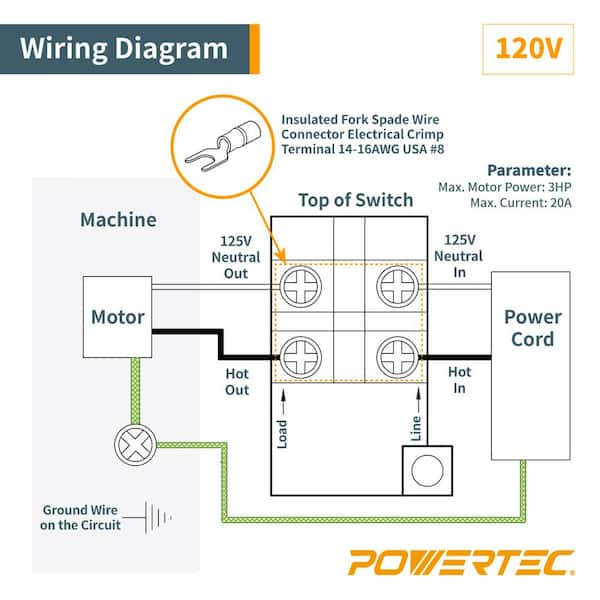To wire a 110 outlet from 220V, you will need to install a step-down transformer for converting the voltage. Upgrading or modifying electrical outlets can be a daunting task, especially when dealing with different voltage requirements.
Perhaps you have recently acquired a device that requires a 110V outlet, but are unsure how to wire it when you only have a 220V power source available. Fortunately, by following a few simple steps, you can easily wire a 110 outlet from 220V.
In this guide, we will walk you through the process of installing a step-down transformer, enabling you to power your device with the correct voltage. So let’s dive into the details and get started with this electrical project.
Contents
Importance Of Safe Wiring
Safe wiring practices are of utmost importance when it comes to electrical installations, especially when dealing with a task like wiring a 110 outlet from a 220V power source.
By following the correct procedures and adhering to safety guidelines, you can prevent electrical accidents and avoid damage to your appliances.
Preventing Electrical Accidents
Preventing electrical accidents should always be a priority when working with electricity. Improperly wired outlets can pose a serious risk of electrical shocks, fires, and other hazards. To ensure safety, it is essential to follow these steps:
- Turn off the power supply before starting any electrical work.
- Use insulated tools to prevent electrical shocks.
- Double-check the connections and ensure they are secure.
- Test the outlet using a voltage tester to ensure it is properly functioning before use.
- If you’re unsure about any step or lack the necessary experience, call a qualified electrician.
Avoiding Damage To Appliances
Wiring a 110 outlet from a 220V power source must be done correctly to avoid damaging the appliances connected to it. Using the wrong voltage can cause appliances to malfunction or even burn out.
Here are some essential considerations:
- Check the electrical requirements of the appliance before connecting it to the outlet.
- Ensure that the voltage converter is properly installed to match the device’s voltage requirements.
- Inspect the wiring to make sure there are no loose connections or exposed wires that can cause short circuits.
- Pay attention to the outlet’s ampere rating and never overload it with appliances that exceed its capacity.
- Regularly inspect and maintain the wiring and outlets to prevent wear and tear that could lead to electrical failures.
By following proper wiring procedures and taking safety precautions, you can ensure that your 110 outlet is wired correctly and safely from a 220V power supply.
Remember, if you are uncertain about any step or lack the necessary knowledge and experience, it’s always best to seek the assistance of a qualified electrician to avoid risks and ensure proper functioning.
Understanding Voltage Differences
What Is 220v?
220 volts is a higher electrical voltage commonly used for heavy-duty appliances like stoves and dryers.
It requires special outlets and wiring, providing more power for large devices.
What Is 110v?
110 volts is a standard electrical voltage for most household outlets and small appliances.
It is safer but provides less power compared to the higher 220V voltage.
Materials And Tools Required
When wiring a 110 outlet from a 220V source, it’s crucial to ensure you have the right materials and tools on hand.
Safety is paramount when dealing with electrical work, so being equipped with the right items will make the process smoother and safer.
Here are the essential materials and tools required for this task.
Wire Cutter
A wire cutter is a vital tool that is required for trimming and cutting wires to the desired length. It ensures that the wires are precisely adjusted to fit the outlet connections, minimizing the risk of loose or exposed wiring.
Voltage Tester
A voltage tester is necessary to determine if the 220V source has been properly shut off before the wiring process begins. This instrument ensures that there is no electrical current running through the wires, preventing potential shocks or accidents.
Wire Strippers
Wire strippers are essential for removing the insulation from the wires, enabling a secure connection to the outlet. These tools come in various sizes to accommodate different wire gauges, providing precision and accuracy during the stripping process.
Electrical Tape
Electrical tape is indispensable for insulating and protecting the exposed wires once the connections have been made. This helps prevent electrical hazards and ensures that the wiring remains secure and insulated within the outlet box.
Step-by-step Guide
Learn how to safely wire a 110V outlet from a 220V source with our step-by-step guide. Our detailed instructions provide a clear and easy-to-follow process for converting your outlet. You’ll gain the knowledge and confidence to complete this project with success.
Shutting Off Power
- Turn off the main circuit breaker.
- Use a voltage tester to ensure the power is off.
Identifying Neutral And Ground Wires
- Locate the white wire for neutral and green or bare wire for ground.
- If unsure, consult an electrician to avoid mishaps.
Re-wiring The Outlet
- Connect the black wire to the brass screw.
- Attach the white wire to the silver screw.
- Join the green or bare wire to the green screw.
Testing The Outlet
- Plug in a tester to check if the outlet is correctly wired.
- If issues persist, seek professional help for safety.
Common Mistakes To Avoid
When it comes to wiring a 110 outlet from 220V, it’s crucial to avoid common mistakes that can lead to safety hazards and electrical issues.
Understanding these mistakes and how to avoid them can help ensure that the wiring process is done correctly and safely. Below are some common mistakes that you should steer clear of when wiring a 110 outlet from 220V.
Incorrect Wiring Connections
Incorrectly wiring the connections when converting a 220V outlet to a 110V outlet can result in electrical hazards and damage to appliances.
It’s important to follow the proper wiring guidelines and ensure that the connections are made accurately to avoid potential safety risks or damage to the electrical system.
Using Incompatible Components
Using incompatible components in the conversion process can lead to malfunctioning outlets, electrical shorts, and even fires.
It’s essential to use the appropriate components and ensure that they are compatible with the 110V system to prevent any potential issues that may arise from using incompatible parts.
Safety Precautions
When wiring a 110 outlet from 220V power, safety precautions are crucial. Before starting, turn off the electricity from the breaker box and confirm that the circuit is dead using a voltage tester. It is essential to follow the proper wiring instructions to prevent electrical hazards.
Using Proper Protective Gear
When it comes to electrical work, safety should always be your top priority. One of the key safety precautions you need to take when wiring a 110 outlet from 220V is wearing the proper protective gear. This will help keep you safe from potential electric shocks and other hazards while working with electricity.
Here are some important protective gear items you should ensure to have on hand:
- Safety glasses: Protect your eyes from sparks, debris, and other potential hazards.
- Gloves: Insulated rubber gloves can help prevent electric shocks and burns.
- Protective clothing: Wear clothing made of non-conductive materials to minimize the risk of electric shocks.
- Respirator mask: If you’ll be working in a dusty or fume-filled area, use a mask to protect your lungs.
Working In A Dry Environment
Another crucial safety precaution to keep in mind when wiring a 110 outlet from 220V is working in a dry environment.
Moisture and electricity don’t mix well, and wet conditions can increase the risk of electric shocks and short circuits. Therefore, it’s important to work in a dry area to minimize these risks.
Here are some tips to ensure a dry environment while working:
- Avoid damp areas: Choose a location for your work that is dry and away from any sources of moisture.
- Turn off power: Before starting any electrical work, always shut off the power at the main circuit breaker to prevent accidents.
- Keep surfaces dry: Make sure all surfaces, including your tools and work area, are dry before beginning the wiring process.
- Use a moisture meter: If you’re unsure about the moisture level in an area, consider using a moisture meter to measure it accurately.
By using the proper protective gear and working in a dry environment, you can greatly reduce the risks associated with wiring a 110 outlet from 220V.
Remember, safety always comes first when dealing with electricity, so don’t take any shortcuts and always prioritize your well-being.
Consulting A Professional
When it comes to electrical work, it’s vital to consult a professional for safety and efficiency.
When To Seek Professional Help
If you’re unsure about wiring complexities or encounter problems, it’s time to contact a skilled electrician.
Finding A Qualified Electrician
Locate licensed electricians in your area, ask for referrals, and check online reviews for credibility.

Frequently Asked Questions For How To Wire A 110 Outlet From 220v
Can I Wire A 110 Outlet From A 220 Outlet?
No, it is not safe or recommended to wire a 110 outlet from a 220 outlet due to voltage differences.
How Do I Get My 220v To Work On 110v?
To use a 220V device on a 110V outlet, you’ll need a step-down transformer. Connect the device to the transformer, which will lower the voltage to 110V, making it compatible with the outlet.
Remember to check the power requirements and wattage of both the device and the transformer to ensure compatibility and safety.
Can I Plug 110v To 220v?
No, you cannot directly plug a 110v device into a 220v outlet. It can cause damage or pose safety hazards. Use a voltage converter or transformer to safely adapt the voltage.
Can You Convert A 240v Outlet To 120v?
No, you cannot convert a 240V outlet to a 120V outlet. Different voltage requirements necessitate separate outlets.
Conclusion
Wiring a 110 outlet from a 220V source involves the right tools and precautions. Safety first!
Always consult a professional for electrical work to avoid hazards. With the right guidance, you can successfully navigate this task. Keep learning, stay safe, and happy wiring!
